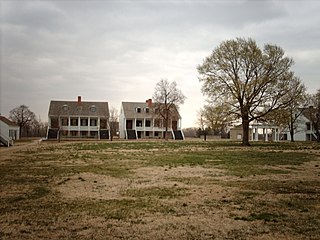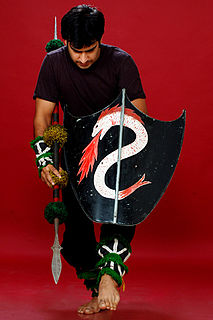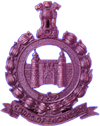A sword is a bladed, melee weapon intended for slashing or thrusting that is longer than a knife or dagger, consisting of a long blade attached to a hilt. The precise definition of the term varies with the historical epoch or the geographic region under consideration. The blade can be straight or curved. Thrusting swords have a pointed tip on the blade, and tend to be straighter; slashing swords have a sharpened cutting edge on one or both sides of the blade, and are more likely to be curved. Many swords are designed for both thrusting and slashing.

General Sir Samuel James Browne, was a British Indian Army cavalry officer in India and Afghanistan, known best as the namesake of the Sam Browne belt. He was a British recipient of the Victoria Cross, the most prestigious award for gallantry in combat that can be awarded to British and Commonwealth forces.

Gatka is the name of an Indian martial art associated with the Sikhs of the Punjab region, and with the Tanoli and Gujjar communities residing in mountainous regions of northern Pakistan who practice an early variant of the martial art. It is a style of stick fighting, with wooden sticks intended to simulate swords. The Punjabi name gatka properly refers to the wooden stick used. The word originates as a diminutive of Sanskrit gada "mace".

Fort Scott National Historic Site is a historical area under the control of the United States National Park Service in Bourbon County, Kansas, United States. Named after General Winfield Scott, who achieved renown during the Mexican–American War, during the middle of the 19th century the fort served as a military base for US Army action in what was the edge of settlement in 1850. For the next quarter century, it was used as a supply base and to provide security in turbulent areas during the opening of the West to settlement, a period which included Bleeding Kansas and the American Civil War.

The Spanish War Service Medal was a United States military medal of the U.S. Army which was established by an act of the U.S. Congress on 9 July 1918. The medal recognizes those members of the Army and of the U.S. Volunteers who performed active duty during the Spanish–American War, but did not qualify for the Spanish Campaign Medal.

The Indian Military Academy is an officer training academy of the Indian Army located in Dehradun. It was established in 1932 following a recommendation by the Indian Military College Committee, which was set up under the chairmanship of Field Marshal Philip Chetwode in 1931. From a class of 40 male cadets in 1932, IMA now trains over approximately 400 gentleman cadets a class, with the total size of the institution being 1,650. Cadets undergo one year of training. On completion of the course at IMA, cadets are permanently commissioned into the army as a Lieutenant.
Indian martial arts refers to the fighting systems of the Indian subcontinent. A variety of terms are used for the English phrases “Indian martial arts”, usually deriving from Dravidian sources. While they may seem to imply specific disciplines, by Classical times they were used generically for all fighting systems.

The Indian Order of Merit (IOM) was a military and civilian decoration of British India. It was established in 1837, although following the Partition of India in 1947 it was decided to discontinue the award and in 1954 a separate Indian honours system was developed, to act retrospectively to 1947. For a long period of time the IOM was the highest decoration that a native member of the British Indian Army could receive and initially it had three divisions. This was changed in 1911 when Indian servicemen became eligible for the Victoria Cross. A civilian division of the IOM also existed between 1902 and 1939, however, it was only conferred very rarely.

The Knight's Cross of the Iron Cross, or simply the Knight's Cross, and its variants were the highest awards in the military and paramilitary forces of Nazi Germany during World War II.

The War Cross with Sword is the highest ranking Norwegian gallantry decoration. It is awarded for extraordinary brave actions or extraordinary leadership during combat. A recipient deemed worthy of additional citations will receive up to an additional two swords on the medal ribbon in addition to the "standard" single sword. Additional citations are rare: Gunnar Sønsteby is the only person to have received the War Cross with three swords.

Huyen langlon is an Indian martial art from Manipur. In the Meitei language, huyen means war while langlon or langlong can mean net, knowledge or art. Huyen langlon consists of two main components: thang-ta and sarit sarak. The primary weapons of huyen langlon are the thang (sword) and ta (spear). The spear can be used in its non-missile form while in close or thrown from afar. Other weapons include the shield and the axe. Unarmed combat incorporates hand strikes, kicks, and grappling (mukna). Because of Manipur's cultural similarity and geographical proximity with Myanmar, huyen langlon is closely related to Burmese bando and banshay.
The Sher-e-Hind was the highest military decoration awarded by the Azad Hind Government, which was an Indian government in exile established in Singapore in 1943. First instituted by Subhas Chandra Bose in Germany, this award was later also awarded to troops of the Indian National Army in South East Asia. The award could be conferred with swords for valour in combat, and without swords for non-combat awards. At least two awards were made, one to Captain Kunwal Singh and one to Capt Ganeshi Lal.
The Sardar-e-Jung was the second highest military decoration by the awarded by the Azad Hind Government. First instituted by Subhas Chandra Bose in Germany, it was later also awarded to troops of the Indian National Army in South East Asia. The award could be conferred with swords for valour in combat, and without swords for non-combat awards. At least two awards were made, one to Colonel Shaukat Ali Malik for the capture of Moirang, and to Capt Shangara Singh Mann. Capt. Mann was also awarded the Vir-e-Hind medal. Colonel Pritam Singh was awarded Sardar-e-jung, he captured a hill named Pritam Hill in Myanmar, Burma & Palel Airport.
The Vir-e-Hind was a military decoration awarded by the Azad Hind Government. The award was a second class star below the award of Sardar-e-Jung. First instituted by Subhas Chandra Bose in Germany, it was later also awarded to troops of the Indian National Army in South East Asia. The award could be conferred with swords for valour in combat, and without swords for non-combat awards. At least one award was made, to Capt Shangara Singh Mann. Capt. Mann was also awarded the Sardar-e-Jung medal.
The Shahid-e-Bharat was a military decoration awarded by the Azad Hind Government to honour the fallen. It was awarded in gold or in silver. First instituted by Subhas Chandra Bose in Germany, it was later also awarded to troops of the Indian National Army in South East Asia. The award could be conferred with swords for valour in combat, and without swords for non-combat awards.

The Corps of Engineers of the Indian Army has a long history dating back to the mid-18th century. The earliest existing subunit of the Corps dates back to 1777 while the Corps officially recognises its birth as 1780 when the senior most group of the Corps, the Madras Sappers were raised.

Major General Mohammed Zaman Kiani was an officer of the British Indian Army who later joined the Indian National Army and was appointed its Chief of General Staff. He earned the Sword of Honour from the Indian Military Academy, and joined 14/1 Punjab Regiment.
The decorations of Azad Hind were instituted by Subhas Chandra Bose while in Germany, initially for the Indian Legion, to be awarded for gallantry in the field of battle. Both Indians and Germans were eligible for the decorations. Later, the same awards were instituted by the Azad Hind provisional government for the Indian National Army during its campaign in South-East Asia.

The Indian Army Medical Corps is a specialist corps in the Indian Army which primarily provides medical services to all Army personnel, serving and veterans, along with their families.

Prince Georgy Ilyich Orbeliani was a general in the Imperial Russian Army during the Russo-Japanese War of 1904-1905.














